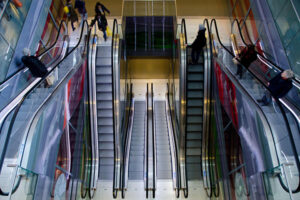By Marcus Neumann
In 1994, Amazon started off as a humble online bookstore. Just over 20 years later, the entire bricks-and-mortar retail industry is repositioning itself by trying to find the best way to interlink offline and online trading. The entire sector has changed drastically, and three types of customers are currently commanding it.

The traditional shopper
They still exist—customers who don’t know where to begin when it comes to online shopping and prefer a traditional shopping experience instead. They drive into a city or to a mall, enter a shop, look at the products, touch them, and try them on/out. The Trade Association Germany and GfK’s online monitor recently discovered that being able to physically look at and touch products was by far the most important reason consumers visit shops.
The hybrid online/offline shopper
According to the online monitor, 41% of customers prefer to research products online before going out to the shops and buying them. They are taking advantage of the best of both worlds. They use the internet for information, to compare, and find reviews of products. The decision to buy, however, doesn’t necessarily have to consist of a mere left click for this type of shopper, but can be made in the shop itself, where the product can be inspected in person.
The die-hard online shopper
This type of shopper considers online retail to be a true blessing. They enjoy the giant selection of products available in all sorts of sizes, styles, and prices that online retailers have to offer. Even when shopping for a specific product, countless opportunities for comparison are available on the internet, ensuring that the best price for almost everything can be found without having to physically travel from shop to shop. For this type of enthusiastic online shopper, having to forgo the actual real-life shopping experience is only considered a small loss. They are happy to be able to go shopping without having to drive to the city, find a parking space, walk through overfilled pedestrian zones, and visit stuffy shops—and that’s without even considering the time saved.
Analyzing what consumers prefer to do online and offline and why is vital to the stationary retail sector’s survival.
One observation is that consumers’ preference for physical shopping is emotionally motivated, whereas they tend to name rational reasons for shopping online. On the one hand, there’s the shopping experience in a city and shop. On the other hand, it is about saving time, money, and effort, and being able to access all this 24/7, which is only possible online.
The stationary trade sector must now manage to do two things: First, it needs to offer an alternative to digital shopping through emotionalization. This includes direct contact to the product and personal contact to other people—to the retail assistant, salesperson, other customers, friends, and acquaintances passing by. The fact that bricks-and-mortar retail possesses this social and communal aspect is a major advantage over online shopping.
Second, stationary retail should not completely close itself off from digitalization in the same way that online retail cannot ignore haptic and personal contact. E-commerce and the stationary trade need to be combined in a symbiotic relationship to succeed. Online retailers like Amazon, Zalando, and Mister Spex are drawn to the high street to provide their customers with personal contact. At the same time, retailers from supermarkets to boutiques are combining online ordering with onsite collection and other services.
The high street won’t die. While total retail turnover has increased eightfold since the 1950s, the distance trade has only seen a rise of 5 percentage points. The market share of e-commerce may currently be growing at a rapid pace, but per GfK forecasts, the market could already be saturated from 2021. High street traders will still see customer potential as long as they draw upon the strengths that set them apart from online retailers.






